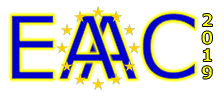Speaker
Description
When long particle beams (compared to the plasma skin depth) propagate in plasma, they can be subject to two competing transverse instabilities: beam hosing and self-modulation. Hosing disrupts the beam and is considered a detrimental effect. Conversely, the self-modulation process can be seeded and exploited in plasma wakefield acceleration experiments to excite high-amplitude wakefields, while also suppressing the hose instability (as in the AWAKE experiment at CERN).
The initial growth stage of these instabilities has been studied in detail and can be described mathematically. Theory suggests, for example, that both instabilities can couple to each other when seeded at comparable levels, with the possible nefarious effect of enhancing hosing. Furthermore, and similarly with laser drivers, we also find that hosing will grow at different rates for different wavelengths of the perturbation (or modes). In this work we build on the available theory to investigate both of these effects, and use particle-in-cell simulations to consider them in regimes that are not accessible to linear theory. A deeper understanding of both the "coupled-hosing" regime and the evolution of different hosing modes will contribute to the evaluation of some of the experimental observations in AWAKE.

